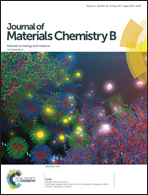Thermally prepared ultrabright adenosine monophosphate capped gold nanoclusters and the intrinsic mechanism†
Abstract
Gold nanoclusters (AuNCs) have been widely applied in fluorescence sensing, bioimaging and phototherapy. Although great progress has been made, the relatively low quantum yield (QY, <10%) in most currently reported AuNCs limits their application greatly. In the present study, adenosine monophosphate (AMP) capped gold nanoclusters (AuNC@AMP) are prepared by using a newly developed heating method in a short time (within 60 min), and are found to show a strong and stable luminescence emission in a relative high QY (14.52%). In addition, an in-depth investigation by employing infrared, 1H and 31P NMR spectroscopy has attributed the origin of such a high luminescence to both the binding of the purine ring and/or the phosphate moiety of AMP as well as their orientations at the gold core surface. In addition, electron-rich atoms such as nitrogen and oxygen, or group moieties such as –NH2 in the ligands can largely promote the luminescence emission of AuNCs. The present study reveals the intriguing generation of ultrabright luminescence from metal nanoclusters, and it will stimulate more research both on the fabrication and practical applications of luminescent metal NCs. With regard to the high QY of these AuNCs, they have great potential for biological applications as adenine is crucially important in life sciences.



 Please wait while we load your content...
Please wait while we load your content...